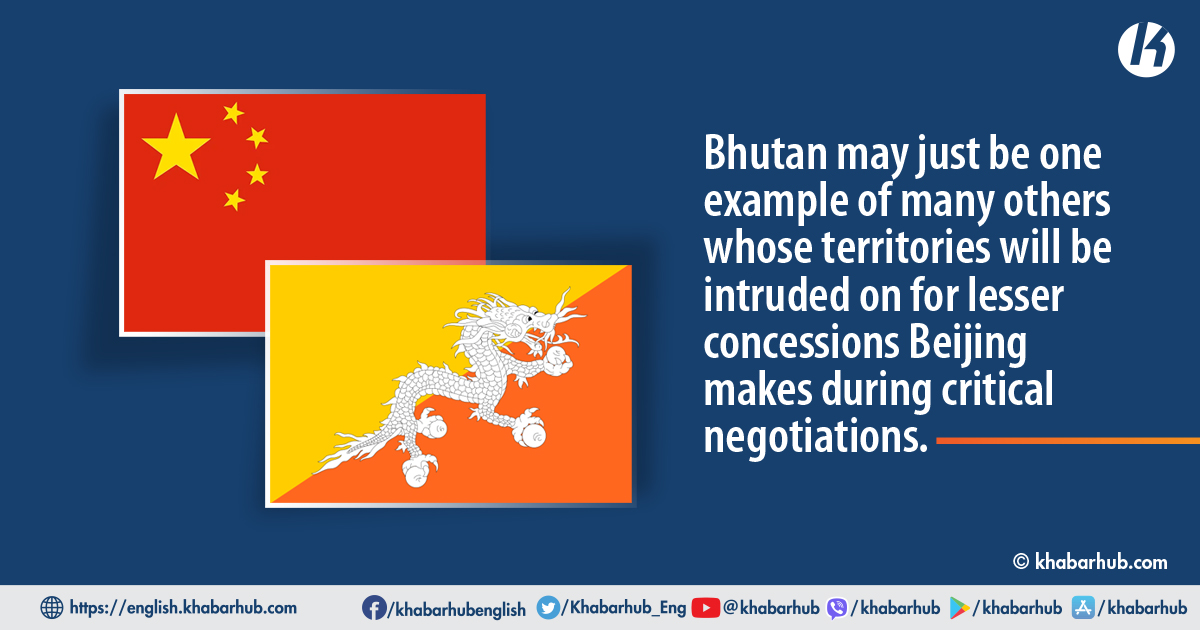Bhutan’s Prime Minister Lotay Tshering earlier this month in an interview claimed that Bhutan and China were getting close to signing a boundary settlement agreement that would permanently demarcate their boundaries.
The Chinese side, which had been notoriously stalling the border negotiations with Bhutan through the ‘Roadmap for Expediating the Bhutan – China Boundary Negotiations’ (Three-Step-Roadmap), has had a history of provoking border disputes with its neighboring countries.
The number of territorial disagreements regarding China currently stands at a staggering 17 disputes with its boundary-sharing nations; of which at least 7 seem to be territorial disputes related to land cover.
These numbers alone suggest that Beijing and its political leadership seek to create conflict and thereafter move towards making significant gains during negotiations.
Bhutan shares an extended 470 km long border with China and is one of the only border nations that does not share its diplomatic relations with China as of yet.
Both countries had signed two treaties in an attempt to resolve their border disputes in 1988 and 1998; until 2021 when a new road map agreement was forged in October that year.
Discussions on border resolutions have been ongoing between the two countries since 1984, with around 24 rounds of talks and at least 10 expert group meetings that had been held since then.
The 3 Step Roadmap was signed between both nations after a break of 5 years in border negotiations due to the Doklam crisis that instilled severe mistrust in both the Bhutanese and Indian sides given China’s misadventure.
Bhutan’s border dispute with the Chinese has largely been based on two separate areas of land.
The dispute has historically also included the India-China-Bhutan tri-junction area of Doklam which measures up to 270 sq. km; the very same region that witnessed a 70-day stand-off between India and China in 2017.
The territorial claim on the Sakteng sanctuary, which is linked and shares a border with Arunachal Pradesh in India is part of that same strategy where the Chinese see negotiations as a method to exert external pressures by laying territorial claims and negotiating from an advantageous position.
Ironically, the three-step roadmap between China and Bhutan does not include the tri-junction area.
However, as an understanding in 2012 between India and China, an agreement stated that any tri-junction dispute would only be resolved with all three countries involved.
The Bhutanese Prime Minister during the interview stated that the Doklam territory was among the aspects that were being discussed for settlement as part of the ongoing negotiations.
Such a settlement if true, can severely impact the dynamics of the South Asian region.
China’s ability to manipulate and gain strategically vital territory between the critical Tri-junction area, would lead many to assess that Beijing would leave no stone unturned in provoking further territorial conflicts with its neighbours in order to gain such advantages.
As understood, the trade-off could be made by conceding the Chinese claim on the regions of Pasamlung and Jakarlung in northern Bhutan nearing Tibet.
In 1997, the Chinese allegedly proposed a ‘package deal’ to Bhutan in which it was willing to trade off the disputed northern and central parts of Bhutan which included the Pasamlung and Jakarlung valleys in return for its western part including Doklam.
This proposal was henceforth rejected as the Bhutanese were not willing to give up their land which secured their strategic interests.
The Chinese on the other hand were clearly targeting the western areas that would bring them strategic advantages with the narrow Chumbi Valley and also give them a vantage point over the Siliguri Corridor through Doklam.
The Chinese in any case have paid little heed to Bhutan’s concern of transgression by building infrastructure on Bhutanese land, which untimely led to the Doklam stand-off causing serious concerns about China’s salami-slicing tactics.
Bhutan may just be one example of many others whose territories will be intruded on for lesser concessions Beijing makes during critical negotiations.
Furthermore, the Chinese side has also extended their territorial claim in 2020, in order to complicate the matter further, by claiming the Sakteng wildlife sanctuary (740 sq km) in Trashigang region in eastern Bhutan.
It is widely understood around the world, that such a claim on eastern Bhutanese territory was made in an attempt to pressure Bhutan to cede some of its most crucial territories in both its eastern and western frontiers.
The territorial claim on the Sakteng sanctuary, which is linked and shares a border to Arunachal Pradesh in India is part of that same strategy where the Chinese see negotiations as a method to exert external pressures by laying territorial claims and negotiating from an advantageous position.
Apart from its territorial claims, China has also built around 200 structures in the region with more constructions underway.
These supposed villages have posed a serious threat to the region and have provided an unwavering advantage to the Chinese side.
These villages not only provide better troop reinforcement monitoring facilities amongst other strategic advantages but also grant greater stake in negotiations to the Chinese side giving it an intelligence as well as a negotiating edge over its counterparts.
Thus, it is important for regional and neighbouring countries to realise that China’s negotiating tactics will ultimately provoke far more greater disputes in the region.
By creating proxy disputes and substituting claims based on strategic calculations, China is attempting to manipulate and force its neighbourhood to agree upon the terms of its convenience.
Bhutan may just be one example of many others whose territories will be intruded on for lesser concessions Beijing makes during critical negotiations.









Comment